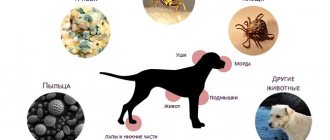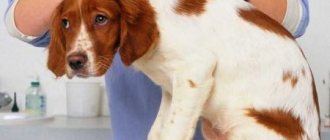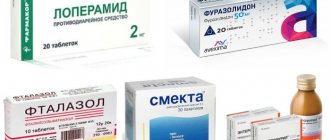What is a disease
This is a painful formation in the thickness of the skin that occurs as a result of the inflammatory process. Inside this formation, pus, microorganisms and fragments of dead tissue accumulate. Intensification of the inflammatory process causes a rapid increase in the size of the abscess or boil.
An inflammatory neoplasm appears on any part of the animal’s body. In this case, both the superficial layers of the epidermis and internal organs are affected. The most dangerous is a perianal abscess (diverticulum), which develops in older individuals. Infection occurs when there is minor damage to the paraanal area.
Symptoms and signs of abscess in dogs
Now let's talk about how to detect an abscess in your pet in time. Are there any basic symptoms that can reliably indicate its presence? Of course, the most reliable sign is a visual manifestation, be it painful redness or a bump swollen with pus on the dog’s withers.
Abscesses of internal organs often go unnoticed altogether, undergoing petrification (petrification), or they are found by chance during an X-ray examination of a dog with severe injuries.
The easiest way to detect old abscesses, the shell of which has already been corroded by purulent exudate accumulated in their cavity.
- The fur in this area is sticky with pus, and the animal often gives off an extremely unpleasant odor.
- If exudate oozes from the cavity for a long time, the fur in this area may completely fall out.
- The resulting bald spot is red, inflamed and hot.
Reasons why an abscess appears in a dog
The disease develops when the skin becomes damaged and infection enters the wound. It provokes inflammation, which leads to rupture of blood vessels. The appearance of a large amount of pus in this place is provoked by the reaction of the immune system.
Thanks to natural healing processes, the wound heals and a kind of pouch with a crust forms. The pathological process will continue until the connective tissue stretches.
The most common cause of an abscess is trauma after a fight with relatives. The infection is transmitted to the wound from the bite almost instantly. If the dog licks the wound in a timely manner, the likelihood of illness is significantly reduced.
An abscess appears when pathogenic microorganisms enter the wound. Certain breeds are predisposed to its development:
- Chinese Shar Pei;
- English bulldog;
- Labrador.
Dogs of these breeds have short and coarse hair. Street dogs are also prone to infection due to poor living conditions and a high likelihood of contact with sharp objects.
Old male dogs develop abscesses due to pathologies associated with the prostate. Bitches are at risk of developing mammary abscess. And also in puppies playing with sharp objects, inflammation appears at the site of the cut.
Triggering mechanisms for the formation of pathology:
- skin damage;
- surgical operations performed in violation of sanitary and epidemiological standards;
- insufficient animal hygiene;
- decreased immunity;
- elderly age;
- development of parasites.
What is an abscess in a dog?
This is what they call a large abscess. It can be closed or open. The first is visible under the skin; there may be a through passage. The open one releases liquid regularly and does not tighten. Abscesses are dangerous because they open the way to all kinds of infections.
The cause is bacteria, a foreign body, tissue unknown to the body. A purulent abscess in a dog appears like this:
- The body detects the bacteria and tries to isolate it.
- Blood flow to the area increases, and leukocytes try to destroy the pathogen.
- An insulating capsule is formed at the site of localization under the skin.
- Pus is dead blood cells.
- If the immune system fails to cope with the problem, the abscess continues to grow.
A capsule rupture leads to the spread of pathogenic microorganisms through the bloodstream throughout the body. This is fraught with serious intoxication and illness. Therefore, abscesses should be taken seriously.
Symptoms: swelling, increased local temperature, pain. Dogs often encounter ulcers, some go away on their own, while others cause discomfort and pain.
Symptoms
Symptoms of the disease depend on the inflammatory response in the body.
With a hot soft tissue abscess, the following symptoms are observed.
- Sharp pain and increased temperature at the site of inflammation.
- Fever. The dog eats poorly, is lethargic and drinks a lot. It is dangerous for the animal, which can die even after several hours of this condition.
- Refusal to go for a walk.
- Stool disorders and inability to sit (with the development of an abscess in the paraanal area). During defecation, the animal feels severe pain.
- Lack of hair around the affected area.
- Leakage of blood and lymph.
With cold abscesses there may be no symptoms. The animal may not have a fever. This type of disease is no less dangerous, as it can last a long time (almost the entire life, depleting the animal).
Types of abscesses
Veterinarians distinguish between these types of abscesses.
| Criterion | Key Features |
| Depending on tissue morphology | Benign or malignant |
| Depending on the course of the pathological process | Active (hot) or cold (chronic) |
| Depending on the depth of the lesion | Superficial, subcutaneous and internal (located on internal organs) |
There are such differences between a benign abscess and a malignant one:
| Criterion | Benign | Malignant |
| Presence of purulent discharge | Thick, white, opaque | Liquid, yellow, cloudy, sometimes bloody |
| Smell | Absent or weak | Foul odor due to active inflammation or release of toxins |
| General condition of the animal | Satisfactory. Sometimes weakness appears and body temperature rises slightly. | The animal is completely exhausted, there is no appetite |
How to open a dog's abscess
An autopsy cannot be performed at home. This is what the veterinarian does. Doctors recommend opening an abscess if it progresses quickly or is advanced. Such procedures are performed in the clinic.
- The affected area is treated with an antiseptic. An anesthetic is administered (for example, an injection of lidocaine).
- An incision is made using a scalpel.
- Using a special syringe, the incision is widened.
- The pus is sucked out and the cavity is cleaned.
- The wound is washed with antiseptic drugs.
- The operation is completed by applying a sterile dressing.
In some cases, the veterinarian installs drainage to drain purulent contents.
If the abscess opens on its own, then the wound is treated with an antiseptic solution, bandaged with a bandage and the dog is shown to the veterinarian.
How is a purulent abscess in a dog treated?
Most dogs present to the veterinarian with an already quite extensive abscess, which can only be treated with surgery . A lateral puncture is made in the abscess, with the help of instruments the doctor pumps out the pus and then installs a drainage, which is saturated with Vishnevsky's liniment or other ointment that has the ability to pump out purulent contents. Fixation with a fairly tight blanket is also necessary. This is necessary so that the wound does not heal too quickly and all the pus comes out. In veterinary practice, there were often cases when, for example, the withers had to be completely opened and this neoplasm had to be removed there, which prevents the pet from living fully and enjoying life.
The animal must necessarily receive appropriate antibiotics , as well as drugs for the treatment of intestinal microflora. Only in this case can we guarantee that recovery will occur as soon as possible.
Veterinary specialists will not only perform surgery at the highest level, but will also help with further rehabilitation. We know how to properly treat an abscess so that it does not pose a threat to your four-legged friend.
A caring owner only needs to notice the first signs of this dangerous disease. In our practice, there have been cases when, due to an advanced disease, the owners consulted a doctor only when it was necessary to remove part of the muscle.
Abscess in a dog - is surgery possible at home?
Nowadays, life dictates an incredibly fast rhythm and not every dog owner has the opportunity to visit a veterinary center, and therefore a completely fair question arises: is it possible to have surgery at home? This is a very responsible procedure that requires high concentration of doctors.
You can call both the YA-VET veterinarian and a surgeon to your home for a preliminary examination, an accurate diagnosis and possible surgery. We will bring everything we need with us - all conditions must be met. Any foreign object, even of a miniature size, can lead to very serious complications.
When to see a doctor
It is necessary to urgently visit a veterinarian in the following cases:
- the affected area of the animal began to rot, the surrounding tissues began to turn black;
- the dog is restless, howls, licks an abscess;
- with active treatment, inflammation does not go away within a week;
- an abscess appeared on the ear, near the eye, genitals and anus.
Treatment of inflammation
In the initial stage, the disease can be easily treated at home. In 90 percent of cases, the inflammation goes away.
Treatment for a dog abscess will vary depending on the location.
- When the paraanal gland is affected, a blue or red formation is noticeable under the butt. The abscess is opened in the clinic, the wound is treated and a sterile bandage is applied.
- An abscess in a dog on the neck, withers or face can be treated independently at home. Monitor the animal’s condition and strengthen its immunity. For intraorbital abscess, the eyes are washed and instilled.
- In aging male dogs, purulent lesions of the prostate develop. The most effective way to treat ulcers is to remove the genital and prostate glands.
Therapy with pharmaceutical drugs
It is possible to use such pharmaceutical drugs.
- Disinfecting solutions. These include hydrogen peroxide and chlorhexidine.
- Application of dressings with ointments: Levomekol, Liniment according to Vishnevsky, Ichthyol ointment. The duration of application of the bandage is from 2 to 12 hours. Carefully ensure that the dog does not tear off the compress.
- The use of immunomodulatory agents to maintain the immunity of dogs. The best immunomodulators are lemongrass or echinacea. The dog’s body is also supported with vitamin C.
- Antibiotic therapy is also an essential part of the treatment of phlegmon or abscess.
- Extensive inflammation and severe pain are relieved by anti-inflammatory and painkillers - such as Analgin, Diclofenac and others.
You cannot prescribe medications or give injections on your own!
Herbal treatment
Tinctures of calendula, nettle and yarrow are used. Herbal preparations are used in the form of compresses. During treatment, the animal should not be allowed to lick or bite the treated area. It is better to use a muzzle.
Traditional medicine is used to combat infection.
- Compresses on the wound with celandine juice. Soak gauze with this juice and apply to the affected area for no more than 10 minutes. The procedure is repeated several times a day.
- Prepare juice from fresh St. John's wort and calendula, mix them. Add 20 drops of a mixture of natural plant juices and a pinch of table salt to a glass of cool water. Wet gauze with this solution and apply to the affected area.
How to get veterinary help as quickly and efficiently as possible - abscess in a dog
Many owners are very concerned about this issue. But we want to say: “Don’t worry!” There are veterinary clinics in many districts of Moscow, which makes a veterinarian visiting your home even more quickly and efficiently. If necessary, it is possible to transport the animal to our veterinary center. If you notice at least one symptom, immediately contact your veterinarian to receive qualified help in order to remove and treat the dog’s abscess.
It is in the veterinary that professionals who sincerely love animals work. Once you turn to us for professional help, you will never want to go to other veterinary clinics again, because this is where the strictness of veterinarians borders on love for pets. You will no longer have to contact several veterinarians, doubting the accuracy of the diagnosis.
Constantly updated equipment in the laboratory will allow you to get the most reliable results. Another equally important factor is that we employ professional laboratory technicians. Show your pet to the veterinarian more often and then problems such as an abscess will bypass your dog.
Consequences of untreated abscesses
The abscess must be treated and removed. If left untreated, the animal will develop sepsis. So, a superficial abscess on the paw or on another part of the body bursts with pus coming out. A large wound appears in its place. If it is not treated, the infection will spread further throughout the body.
When a dog develops an internal abscess, if it is not removed, the contents can leak into the body's internal cavities. When pus enters the abdominal cavity, the dog develops peritonitis. It is difficult to save the animal.
Content
1. Types of abscess on a dog’s paw 2. Causes of occurrence 3. Symptoms 4. Treatment 5. Preventive measures
An abscess on a dog’s paw is a phenomenon that can be encountered quite often. Moreover, the intensity and complexity of the manifestations does not depend at all on the breed of the dog, its size, weight and even age. Every pet is potentially susceptible to this very unpleasant and sometimes downright dangerous disease.
Moreover, the size of the affected area itself can vary over a wide range, from a small “bead” to a “chicken’s egg”. Interesting. That the border of the abscess is clearly visible and separated by a red line. It is important to understand that purulent formations can appear not only on the paws (although this is the most common case), but also in other places - the torso, head, even on the tail. But the worst thing is if an abscess appears on the internal organs.
Prevention
It is very difficult to protect your four-legged pet from developing abscesses. To do this, the owner is recommended to:
- After a walk, check the paws and wipe or wash them.
- The dog must eat well. This is a guarantee of strong immunity.
- Give the animal multivitamin preparations at least 2 times a year.
- Disinfection of cuts and injuries is necessary. They are treated with hydrogen peroxide and chlorhexidine.
- Bath your dog regularly.
- Vaccinate the animal. In this case, immunity is formed and the risk of infection is reduced.
The dog must have a collar while walking. If a dog lives in the yard, it should be in an enclosure. An animal living in an apartment should be regularly walked in a safe place where the risk of infection is minimal.
Treatment
There are various ways to treat paw abscess in dogs, including traditional ones, at home. All of them are relevant to one degree or another. However, the optimal solution to the problem, of course, is surgical intervention. If we are talking about internal inflammation, then in general this option is not discussed.
Owners, by and large, do not need to worry. If the veterinarian is sufficiently qualified and carried out under sterile conditions with the appropriate instrument, the operation is absolutely safe for the animal, is performed under anesthesia, and, as a result, is painless.
However, there is one important point that should not be forgotten. The dog will try to lick the wound after surgery, but this cannot be allowed. As a result, it is necessary to use a special plastic collar in the first days of rehabilitation, until the wound is completely dry.











